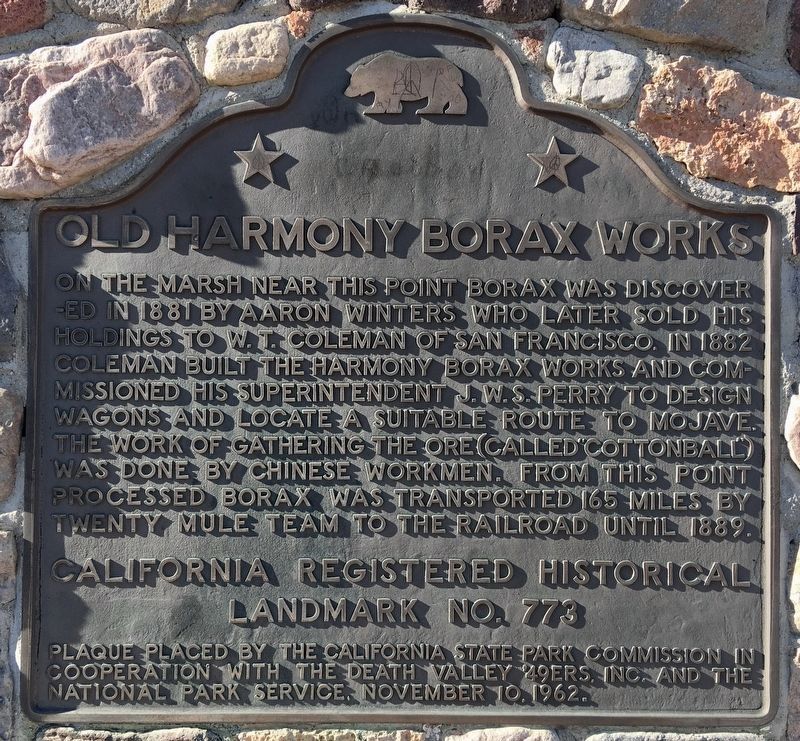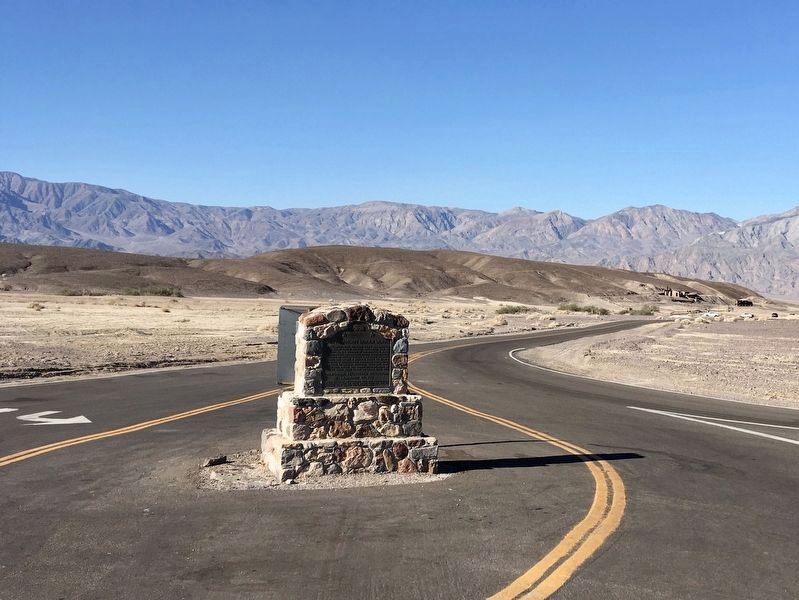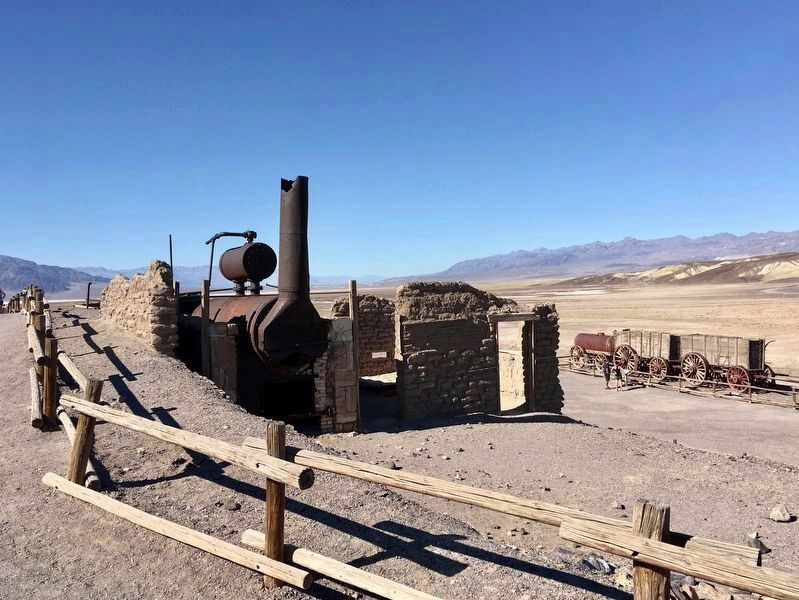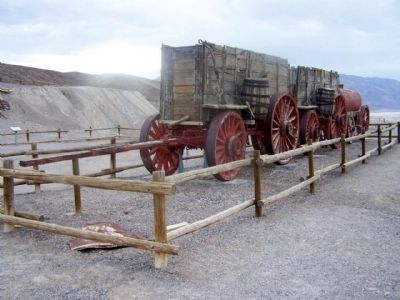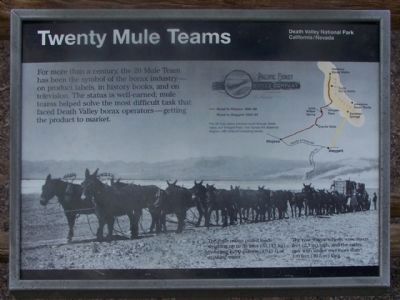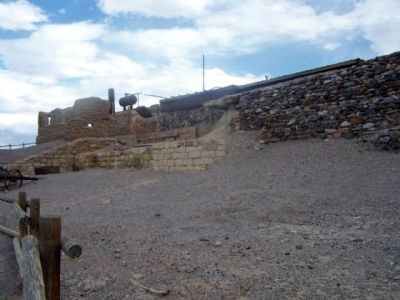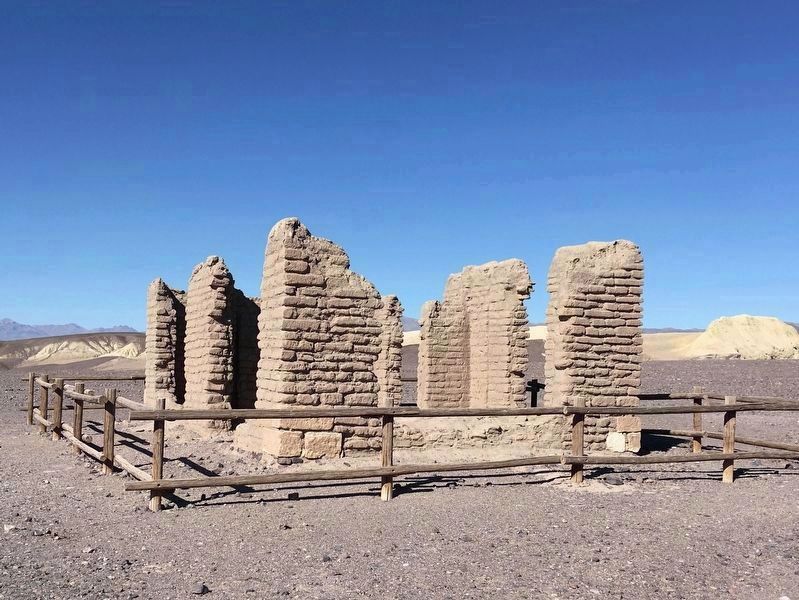Death Valley National Park in Inyo County, California — The American West (Pacific Coastal)
Old Harmony Borax Works
Erected 1962 by California State Park Commission; Death Valley 49ers Inc.; and National Park Service. (Marker Number 773.)
Topics and series. This historical marker is listed in these topic lists: Industry & Commerce • Natural Resources • Notable Places. In addition, it is included in the California Historical Landmarks series list. A significant historical year for this entry is 1881.
Location. 36° 28.797′ N, 116° 52.184′ W. Marker is in Death Valley National Park, California, in Inyo County. Marker is at the intersection of California Route 190 and Borax Mill Road, on the left when traveling north on State Route 190. Touch for map. Marker is in this post office area: Death Valley CA 92328, United States of America. Touch for directions.
Other nearby markers. At least 8 other markers are within 3 miles of this marker, measured as the crow flies. White Gold (approx. 0.3 miles away); Twenty Mule Teams (approx. 0.3 miles away); Borax (approx. 0.3 miles away); Stephen Tyng Mather (approx. 1.3 miles away); Old Dinah (approx. 1.6 miles away); 20 Mule Team Wagon Train (approx. 1.6 miles away); Furnace Creek Ranch, Death Valley (approx. 1.6 miles away); Death Valley 49ers Gateway (approx. 2.4 miles away). Touch for a list and map of all markers in Death Valley National Park.
Regarding Old Harmony Borax Works. This site was designated California Historical Landmark No. 773 on August 16, 1962.
Related markers. Click here for a list of markers that are related to this marker. — 20 Mule Team routes.
Also see . . . Death Valley History. - Harmony Borax Works (Submitted on June 15, 2010, by Mike Stroud of Bluffton, South Carolina.)
Additional commentary.
1. Borax
Borax, also known as sodium borate, sodium tetraborate, or disodium tetraborate, is an important boron compound, a mineral, and a salt of boric acid. It is usually a white powder consisting of soft colorless crystals that dissolve easily in water.
Borax has a wide variety of uses. It is a component of many detergents, cosmetics, and enamel glazes. It is also used to make buffer solutions in biochemistry, as a fire retardant, as an anti-fungal compound for fiberglass, as an insecticide, as a flux in metallurgy, a texturing agent in cooking, and as a precursor for other boron compounds.
— Submitted June 16, 2010, by Mike Stroud of Bluffton, South Carolina.
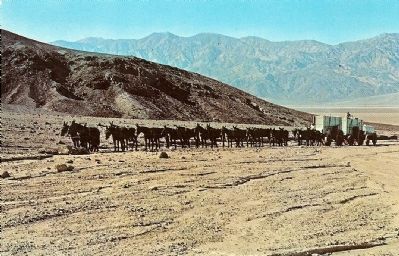
Death Valley Natural History Assoc-Decker Press, Inc. Photo by Warren Hill
8. Vintage Postcard - Typical Twenty Mule Team Outfit
During the 1880's, the twenty mule teams hauled borax from the refinery at Harmony Borax Works to the railroad at Mohave, California, 165 miles away. The twenty mule teams hauled loads of 36 1/2 tons and made the trip to Mojave in 10 days, maintaining almost timetable precision. The triumph of the twenty mule teams over the harsh desert was tremendous, but brief. In 1888 the great wagons and the twenty mule teams made their last trip out of Death Valley.
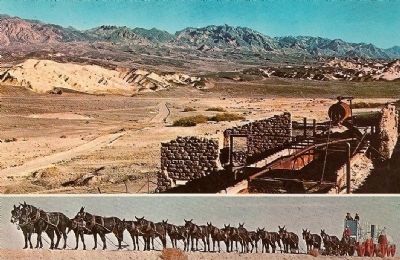
9. Vintage Postcard - Old Harmony Borax Mill-Death Valley, California
The ruins of the old mill, a few miles north of the Furnace Creek Ranch, which was in operation from 1883 to 1987. A 20 mule-team could haul 46,000 pounds of borax and its own water and hay on the arduous ten day, 165 mile trip to Mojave via Wingate Pass. Truly one of the great legends of the West
Credits. This page was last revised on August 20, 2023. It was originally submitted on June 15, 2010, by Mike Stroud of Bluffton, South Carolina. This page has been viewed 1,575 times since then and 60 times this year. Last updated on October 30, 2020, by Craig Baker of Sylmar, California. Photos: 1, 2, 3. submitted on October 30, 2020, by Craig Baker of Sylmar, California. 4. submitted on June 15, 2010, by Mike Stroud of Bluffton, South Carolina. 5. submitted on June 16, 2010, by Mike Stroud of Bluffton, South Carolina. 6. submitted on June 15, 2010, by Mike Stroud of Bluffton, South Carolina. 7. submitted on November 6, 2020, by Craig Baker of Sylmar, California. 8, 9. submitted on September 29, 2008, by Syd Whittle of Mesa, Arizona. • Syd Whittle was the editor who published this page.
